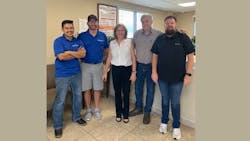Collision repair has faced an incredibly turbulent last half decade. There continues to be growth and new opportunities, but even that presents a new set of challenges that needs to be addressed.
Data from a CCC Intelligent Solutions report published at the end of last year shows repair volume continues to return to pre-pandemic levels, but that also means shops have to keep producing amid technician shortages, still ongoing supply chain troubles and increasing expectations from customers.
Almost all of the challenges that collision repair as a whole faces can be traced back to overarching theme that is summarized best by the 2023 FenderBender Industry Survey: People don’t realize how advanced and adaptable the industry is.
“The world as a whole, including the consumer and insurance companies, believe that we are still fixing cars like we did 30 years ago, or even 10 years ago,” the report says. “An updated mindset on cost to complete repairs and the necessary procedures required to do so is vital to this industry moving forward successfully.”
Most of the challenges that the industry faces today aren’t new. I-CAR President and CEO John Van Alstyne says many of the “new” technologies that are present in cars today, such as different ADAS systems, have been around in some form for 20 years or so. Instead, the difficulty comes from the fact those technologies are now reaching a critical mass and have become prevalent in everyday repairs. In order to fix cars, shops have to fix those devices.
“There's been an acceleration of change,” Van Alstyne says. “The scale is getting to a point where decisions have to be made as to how we really deal with these technologies effectively because it's impacting virtually every repair today.”
Addressing the key areas of tools, your technicians and expectations can set your shop up for success, both now and in the future.
Technicians
Auto shops across the country face a plethora of challenges, but the tech shortage remains at the top of the list.
Data from the 2023 FenderBender Survey shows the industry will need 113,000 new technicians by 2026, but it’s not likely that number will be met. In 2022, there were 4,487 new techs entering the field to fill 35,239 open positions.
Across all regions surveyed in the survey, around 42 percent of respondents said the tech shortage was their No. 1 concern, an 8 percent increase from last year and the second year in a row that the shortage ranked first.
According to Steve Wurtz, owner of Blue Ash Auto Body in Cincinnati, Ohio, the shortage isn’t necessarily about the lack of an opportunity for prospective technicians. In fact, he says it’s quite the opposite.
“They get an opportunity that is unbelievable,” Wurtz says. “Within five years of being out of vocational school, they can be making $100,000 a year or better. And they have the knowledge to where, as the industry grows and more and more shops are coming on board, they can be the ones going into a shop and leading it in the future.”
In order to maximize that opportunity, though, Wurtz says shops need to make continual investments in their employees. Van Alstyne agrees and says that shops need to stop comparing their own job openings against just other shops' – instead, they need to really focus on making their shop an attractive workplace regardless of industry.
“The general public has too many options before them in terms of where they want to spend their life journey working. There are a lot of benefits to collision repair, but not everybody sees that,” Van Alstyne says. “For the individual business owner, it's about stepping up your game. Make those strategic investments that help in the development and the retention of employees.”
One of the most sustainable ways to do that is through industry trainings. Investing time and resources into your technicians both shows that your employees are valuable to your business and helps your shop stay up to date on new OEM requirements, trends and other technologies.
Data from the 2023 FenderBender survey shows that 56 percent of respondents attend industry-specific trainings at least once a year, and nearly 64 percent of respondents say at least one member of their team attends trainings at least once annually.
On the other side of that coin, though, 11 percent of respondents says no one from their shop ever attends industry-specific technical training, and for 14 percent, their shop doesn’t pay for any training.
Shops need to do what they can to invest in their employees in order to be an attractive employer for prospective employees out on the job market.
“It's incumbent on businesses to figure out how to stay abreast of the developments in the industry,” Van Alstyne says. “That includes repair methods and technology, but it also boils down to being able to retain people.”
Tools
Wurtz has been the owner of his shop since 1976. Over the last 50 years, he’s expanded his shop several times to account for the growing needs of his business. Even now in his 70s, he’s still investing in the shop’s technology.
Right now, he’s looking into different options for an ADAS calibration setup.
“My kids are like, ‘Dad, when are you going to retire? Are you done?’” Wurtz asks. “And here I'm taking a mortgage for another million dollars to find another building.”
Though his shop has expanded significantly, ADAS is still something that his shop has to subcontract out to other shops.
“Call me a control freak or whatever,” he says. “I'm not comfortable with that.”
Shops across the country are also placing more emphasis on being able to do ADAS repair in-house. Thirty-one percent of respondents to the industry survey say their shop is equipped to perform ADAS calibrations, a 10 percent increase from just two years ago.
It’s not just ADAS, either. Scan tools are also quickly becoming essential as more OEMs start requiring them to be certified to perform repairs on their vehicles. The survey shows that the number of shops that own two or more scan tools has risen steadily over the last couple of years, now sitting at 46 percent. Slightly less than two-thirds of respondents say they use a third-party service such as asTech for scans.
Almost every part of the business, from the actual repair work to how you communicate with customers, is undergoing a massive technological revolution. Wurtz says investing in the tools necessary to perform at a high level is no longer optional.
“It is time to get serious and invest in your business,” he says. “Put your profits back into the business.”
Expectations
There are more cars on the road than ever before in the U.S., hitting 284 million in 2022. These vehicles are more complex than ever, too – data from the industry survey shows just under half of all vehicle systems are expected to be powered by semiconductor chips by the end of the decade.
Despite all of that and how highly skilled collision shops need to be, the perception of what goes into a repair has remained dreadfully archaic.
“One of the biggest misconceptions is that the repair process is simple,” the survey says. “Many people think that we are just fixing some dents and putting some paint on their vehicle. Repairs are increasingly complex.”
Consumer behavior has been forever changed in a major way post-pandemic. People are increasingly impatient and requiring more accommodations and updates throughout a repair process despite being aware of still-ongoing labor and supply shortages.
And if that weren’t enough, insurance companies are becoming increasingly stubborn in negotiations, sometimes flat-out refusing to pay for OEM-required repairs because they deem it too expensive. New estimating technologies that rely on AI are exacerbating the problem, too.
“Everything they're doing to try to make it easier on the insurance industry is not making it easier on us,” Wurtz says. “Estimating companies are now coming out with virtual reality where you take a photograph of the vehicle and then you’ve got an estimate. It’s going to save theinsurance companies a lot of time and money, but that doesn't mean you’re going to get an actual blueprint on how that car has to be repaired.”
All of the expectations facing a modern repair shop can be overwhelming, and Wurtz says the state of the industry has gotten to a point where having a dedicated team approach is no longer optional. Shop owners have to change their own expectations.
“People are going to have to realize they can't do it on their own,” Wurtz says. “You have to develop a team to work with within your facility and be able to rely on them, trust them and let them run with the ball.”
Data from the survey shows at least 68 percent of respondents had some form of team approach when repairing individual vehicles, but Wurtz says that team mentality approach needs to be taken to the macro level management of the entire shop.
Having team members delegated to handling important tasks — such as documenting procedures and steps taken during a repair to have a hard paper trail when preparing to negotiate with insurance or making sure customers are getting updates on their vehicles in a timely manner — is crucial to make sure your shop is meeting the growing expectations of your customers, insurance and other stakeholders.
Looking Ahead
Collision repair is an incredibly resilient industry, and that resilience is being tested. More than ever, industry professionals need to keep up to date with new trends, tools and technologies to remain relevant. Though it may seem daunting, Van Alstyne says the bottom line for the industry is the same.
“The collision repair industry is in the business of fixing cars, right? And if you're in the business of anything, businesses continuously evolve and change. You have to continue to make adjustments as you go into the future with any business,” Van Alstyne says. “It’s not just one magic silver bullet. It's just stepping up our game collectively as an industry and as individual business owners.”
Collision repair will always be necessary, and Wurtz says there will always be opportunities for those that invest. That investment is just no longer optional.
“There are opportunities out here that are just enormous,” he says. “You have to be paying attention to what's going on in the future.”
About the Author

Noah Brown
Noah Brown is a freelance writer and former senior digital editor for 10 Missions Media, where he facilitated multimedia production several of the company's publications.
